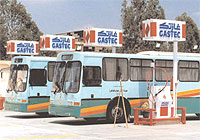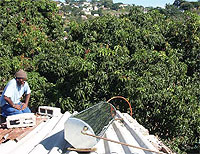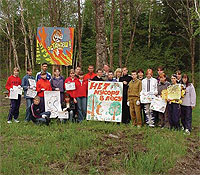 |
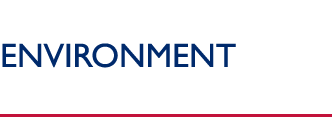 |
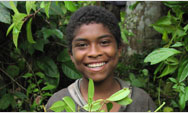 |
|||||||||
Addressing the causes and effects of climate change has been a key focus of USAID’s development assistance for over a decade. USAID has funded environmental programs that have reduced greenhouse gas emissions while promoting energy efficiency, forest protection, biodiversity conservation, and other development goals. This “multiple benefits" approach to climate change helps developing and transition countries achieve economic development without sacrificing environmental protection.To help countries address domestic and international climate change priorities, USAID’s Global Climate Change Program is active in more than 40 countries and, since 2001, has dedicated over a billion U.S. dollars to promote:
USAID places particular emphasis on partnerships with the private sector and on working with local and national authorities, communities, and nongovernmental organizations to create alliances that build on the relative strengths of each. Bringing together a diverse range of stakeholders helps avoid unnecessary duplication and lays the foundation for a sustained, integrated approach.Through training, tools, and other means of capacity building, USAID helps developing and transition countries address climate-related concerns as a part of their development goals. Clean Energy Technology
New technologies and practices offer the prospect for continued economic growth with reduced greenhouse gas emissions. Recognizing that increased productivity and efficiency are critical to economic growth, USAID supports the commercialization, dissemination, and widespread adoption of environmentally sound technologies. Attracting private investment is essential to popularizing such technologies. Recognizing that energy is one of the major expenditures for poor families living in urban townships, USAID promotes the use of low-cost solar water heating units in South Africa, which reduce household energy consumption and costs while providing hot water to households that could not otherwise afford it. USAID/India’s Greenhouse Gas Pollution Prevention Project reduces emissions through efficient power generation and increased use of clean energy technology, including electric cars, clean coal, and energy generation with sugar cane waste (bagasse).
Sustainable Land Use and ForestryPromoting biodiversity conservation, improved forest management, and sustainable agriculture, USAID programs in more than 25 countries help mitigate climate change by absorbing and storing carbon dioxide from the atmosphere. They also help reduce the vulnerability of ecosystems to climate change. Reduced-impact logging of forests minimizes loss of vegetative cover, for instance, which helps stabilize the soil and prevent it from eroding away during rain and windstorms. Reduced tillage and contour planting by farmers increases soil organic carbon and therefore enhances soil fertility, which helps increase food security in developing countries. To better understand the carbon effects of such land management strategies, scientists, policymakers, and landowners in the international community need improved methods for monitoring carbon sequestration in soil-plant ecosystems. Thus, USAID is not only promoting activities that preserve carbon stocks but is also helping to develop methodologies for measuring changes in carbon stocks in USAID’s land use and forestry projects in areas such as the Congo Basin. Adaptation to Climate ChangeUSAID supports activities to help developing countries lessen their vulnerability and adapt to climate variability and change.These activities are intended to build more resilience into economic sectors that may be affected by climatic stresses, including agriculture, water, and key livelihood sectors in coastal areas. In Indonesia, USAID’s Coastal Resources Management Project (CRMP) helps coastal communities to sustainably manage fisheries, reefs, and other coastal resources. Participating villages and communities develop long-term plans to protect resources, such as ensuring that their coastline is protected from floods and storm damage by healthy stands of mangroves. Climate Science for Decision-MakingUSAID is involved in U.S. and international climate change research to ensure that science addresses information needed for global development challenges and that scientific findings are used to guide development planning. Informed policy decisions are essential to sustainable natural resource management and economic development, key priorities of USAID. For example, USAID supports long-term research partnerships between U.S. universities, developing country research institutions, U.S. agribusiness, and private voluntary organizations through Collaborative Research Support Programs (CRSPs). CRSPs research issues of agricultural productivity and sustainability, food quality, and natural resource management that benefit both developing countries and the U.S. Download the Global Climate Change Brochure, October 2006 (PDF 253K) |
|||||||||||
|

